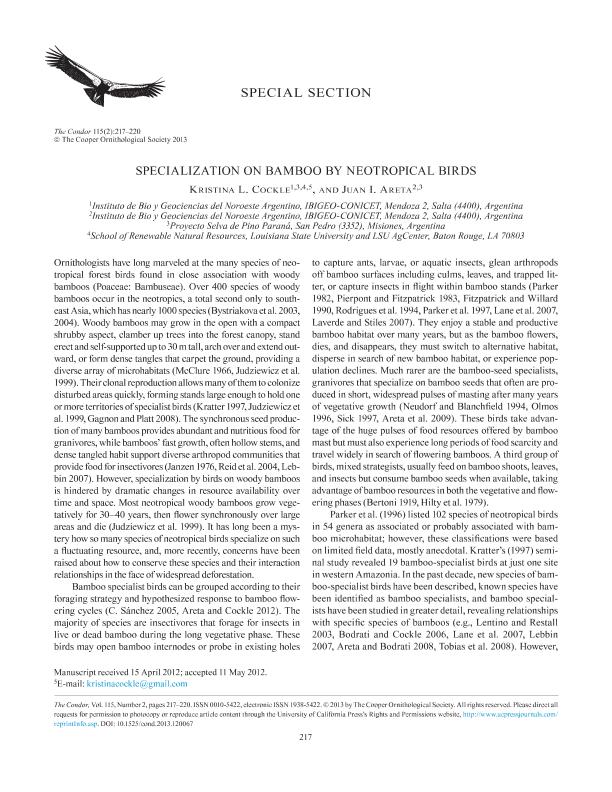Artículo
Specialization on bamboo by Neotropical birds
Fecha de publicación:
05/2013
Editorial:
Cooper Ornithological Society
Revista:
The Condor
ISSN:
0010-5422
e-ISSN:
1938-5129
Idioma:
Inglés
Tipo de recurso:
Artículo publicado
Clasificación temática:
Resumen
Ornithologists have long marveled at the many species of neotropical forest birds found in close association with woody bamboos (Poaceae: Bambuseae). Over 400 species of woody bamboos occur in the neotropics, a total second only to southeast Asia, which has nearly 1000 species (Bystriakova et al. 2003, 2004). Woody bamboos may grow in the open with a compact shrubby aspect, clamber up trees into the forest canopy, stand erect and self-supported up to 30 m tall, arch over and extend outward, or form dense tangles that carpet the ground, providing a diverse array of microhabitats (McClure 1966, Judziewicz et al. 1999). Their clonal reproduction allows many of them to colonize disturbed areas quickly, forming stands large enough to hold one or more territories of specialist birds (Kratter 1997, Judziewicz et al. 1999, Gagnon and Platt 2008). The synchronous seed production of many bamboos provides abundant and nutritious food for granivores, while bamboos’ fast growth, often hollow stems, and dense tangled habit support diverse arthropod communities that provide food for insectivores (Janzen 1976, Reid et al. 2004, Lebbin 2007). However, specialization by birds on woody bamboos is hindered by dramatic changes in resource availability over time and space. Most neotropical woody bamboos grow vegetatively for 30–40 years, then flower synchronously over large areas and die (Judziewicz et al. 1999). It has long been a mystery how so many species of neotropical birds specialize on such a fluctuating resource, and, more recently, concerns have been raised about how to conserve these species and their interaction relationships in the face of widespread deforestation.
Palabras clave:
Chusquea
,
Guadua
,
Merostachys
,
Oxytenanthera Abyssinica
Archivos asociados
Licencia
Identificadores
Colecciones
Articulos(IBIGEO)
Articulos de INST.DE BIO Y GEOCIENCIAS DEL NOA
Articulos de INST.DE BIO Y GEOCIENCIAS DEL NOA
Citación
Cockle, Kristina Louise; Areta, Juan Ignacio; Specialization on bamboo by Neotropical birds; Cooper Ornithological Society; The Condor; 115; 2; 5-2013; 217-220
Compartir
Altmétricas




